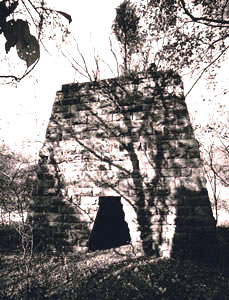
Stewart County
Created in 1803 from Montgomery County, Stewart County is named for an early pioneer and speculator, Duncan Stewart. Originally inhabited by nomadic hunters and mound builders, the area received white settlers in the 1780s, as Revolutionary War veterans arrived to claim land grants. The fertile bottomland attracted immediate interest, but the area’s substantial iron deposits also drew attention. Several factors, including the location of deposits between the easily navigable Tennessee and Cumberland Rivers, the availability of slave labor to operate the furnaces, and timber for fuel, produced a thriving iron industry that lasted for over a century.
The county’s boundary lines have changed repeatedly. Today, the county encompasses 458 square miles; its population in 2000 was 12,370, representing a 30 percent increase since 1990. State and federal agencies control over 44 percent of the land in the county. Modern highways have replaced the Tennessee and Cumberland Rivers as the primary transportation arteries. A Cumberland City ferry is the last remnant of a service rendered obsolete by the construction of bridges throughout the county. However, many place names indicate the county’s geography and cultural history: Tobaccoport, Bumpus Mills, Big Rock, Bear Springs, Model, Bellwood, Leatherwood, Indian Mound, and Cumberland City.
In 1805 a state-appointed commission purchased a 30-acre plot on the Cumberland River from Robert Nelson and established the county seat of Dover. By 1850 the frontier town had blossomed into a large river trade center and the second largest steamboat port on the Cumberland. During the Civil War, Union troops, who had occupied the town since the fall of Fort Donelson in 1862, set fire to Dover to prevent the town from falling into the hands of General Nathan Bedford Forrest; only four buildings survived the conflagration. Today, a mayor and four aldermen govern the 2,000 citizens of Dover. The city oversees the operation of modern utility systems, and citizens enjoy the benefits of up-to-date medical facilities. Dover has a weekly newspaper, the Stewart-Houston Times, and a radio station, WTWL-101.5. An automotive assembly plant and a garment factory provide employment.
Cumberland City, the second largest city, was established in 1814. Prior to 1860, it was known as Bowling Green, but changed the name to Cumberland to eliminate confusion with Bowling Green, Kentucky, which was also on the Louisville and Nashville Railroad. The word “City” was added by citizens who anticipated a great future for their town. The town is perhaps best known for the Cumberland City Academy, which was founded in 1893 by W. T. Thomas. Before statehood, Methodist circuit-riding preachers conducted campground meetings at the site of the McKendree Church, the oldest church in the county. Today, Cumberland City looks much as it did at the turn of the twentieth century, except for the presence of one of the largest coal burning steam plants in the world, constructed by the TVA in 1968. Adjacent to the steam plant is Stewart-Houston Industrial Park, which houses several modern manufacturing operations.
Many other county communities were once bustling towns. Bumpus Mills derives its name from Andrew Bumpus, who built a sawmill, gristmill, flour mill, and planing mill on Saline Creek in 1846. The mills thrived and were best known for the production of Bob White Flour. Big Rock was a hub of activity for tobacco farmers at the turn of the century. A tobacco prizing warehouse established in 1915 by C. W. Joiner and William Martin attracted tobacco men from the area. Although Big Rock remains an important county community, the development of Fort Campbell in the 1940s greatly diminished the town’s size and population. Indian Mound was named for the prehistoric burial mounds located in the community. Early settlers recognized the mounds and recorded their presence in early court records and deeds. The community developed with the establishment of two iron furnaces. When the furnaces closed, the population of the community declined.
As the era of the iron industry passed, the economy depended more heavily on the earlier established farming and timber industry. Cotton was among the first crops grown in the early 1800s, but it declined in production due to low yields caused by poor soil conservation practices. Both dark-fired and burley tobacco were introduced into the area in the early 1800s, but dark-fired tobacco dominated and continues as the county’s primary cash crop. In fact, the region is known as the “Dark-Fired Capitol of the World.” In addition to tobacco, Stewart County farmers produce corn, wheat, and soybeans.
Timber has always been one of the county’s greatest natural resources. As early as the 1830s trees were harvested for the production of charcoal to fuel the iron furnaces and steam boats. As the railroad expanded, local farmers provided crossties to meet increasing demand. Even today, hundreds of acres of timber are managed by Westvaco and a number of sawmills continue in operation.
Stewart County contains a number of sites of recreational, educational, and historical interest. Kentucky Lake and Lake Barkley offer opportunities for fishing and boating. Cross Creek Wildlife Refuge and the Land Between the Lakes provide nature lovers sightings of eagles, wild geese, turkey, and deer. The 1850 Homeplace, a living history farm, furnishes entertainment and education for all ages. For Civil War buffs, Fort Donelson National Battlefield and Cemetery and Surrender House, the site of Buckner’s surrender to Grant, are popular attractions.



